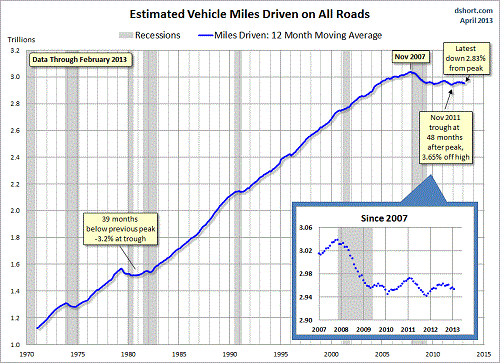Happening Now
The Multi-Modal Era is Upon Us (Again)
April 25, 2013
Written By Malcolm Kenton
During the Great Recession of the 2000s, Americans traveled considerably less--both within and between cities and regions--as many lost jobs, worked fewer hours, and had less money to spend. After previous economic downturns in the "automobile age," vehicle miles traveled (VMT) was one of the first indicators to resurge. But while general travel rates have rebounded over the past couple of years, the amount of miles Americans drive has continued to drop.

Travel on all US roads dropped 1.4 percent, or roughly 3.1 billion miles driven, in February 2013 compared with February 2012, according toFederal Highway Administration data. This while cumulative travel declined only 0.4 percent over the same period.
Since June 2005, VMT on all US roads has sunk an estimated 8.75 percent, according to Advisor Perspectives researcher Doug Short. Indications are that the recession is not the only cause of this trend. Gas prices have been fluctuating greatly over the past few years, but the correlation between gas prices and miles driven is actually rather weak.
More relevant factors include the aging population (seniors moving to areas where they don't need to drive as much), continuing high unemployment, the increased ability to telecommute made possible by the Internet, and the increased availablity of attractive and reliable public transportation (witness the growth of rail transit systems in such places as Denver, Dallas, Salt Lake City and Seattle).
But what should be most encouraging to passenger train and transit advocates, and something NARP has been highlighting in our communications with those on Capitol Hill, is that car reliance is falling noticeably out of favor with young Americans. : An April 2012 Frontier Group study notes, “From 2001 to 2009, the average annual number of vehicle-miles traveled by young people (16 to 34-year-olds) decreased from 10,300 miles to 7,900 miles per capita—a drop of 23 percent."
Over that period, 16-to-35-year-olds took 24% more bicycle trips and were 16% more likely to walk to their destinations. And from 2000 to 2010, the share of those ages 14 to 34 without drivers' licenses grew by 5%.
Frontier Group reports that many young people now prefer to live where they can walk, bike or take public transportation--whether because these modes are more attractive in and of themselves, for environmental reasons, or because they allow you to stay connected electronically while in motion.
The walkable, bikeable communities with robust transit that are attractive to young Americans don't just happen on their own, and that's why the few such places that do exist are so expensive to live in--the demand for a car-lite lifestyle far exceeds the supply of places where it is possible.
Of course, many of the walkable places that do exist are holdouts from an era before the automobile became dominant, and were built around train stations or streetcar lines (with earlier settlements organizing around rivers and harbors, designed to be traversed on foot, on horseback or by horse-drawn carriage). So encouraging multi-modalism simply means reverting to the patterns by which human habitations had developed for centuries before the car took over and most of the principles of urban planning were changed to make it more attractive to drive most places than to walk.
Many policy changes are needed to transform communities nationwide into the kind of places where driving is not absolutely necessary, but chief among these should be greater and more consistent investment in passenger trains--both within and between cities.
Intercity train corridors offering frequent, reliable service that's trip-time competitive with driving are needed to sustain the economic viability of regions and attract and retain young professionals in the cities and towns along their routes. And an expanded network of reliable and economical long distance trains must connect these regions together and to intermediate small towns and rural communities that are being left without travel options as air and intercity bus networks shrink.
The direction the public is taking in their travel choices is clear. Will policy makers get out ahead of the curve and make the investments necessary for smarter mobility? Or will communities that stubbornly cling to car culture get left behind, and by extension forfeit the United States' competitive advantage to countries that have more livable places and better travel choices?
"On behalf of Amtrak’s onboard service staff, I want to thank the Rail Passengers Association for honoring their hard work with this award. The past couple years have indeed been difficult for Amtrak onboard service staff – coping with furloughs and job insecurity, adapting to changing protocols and services, not to mention the unfortunate events such as a tragic derailment and a fatal shooting. Nevertheless, our dedicated members at Amtrak have handled these hurdles with the care, attention and diligence for which they’re known. We thank Rail Passengers for their acknowledgement of our members’ hard work and, as always, look forward to seeing you on the rails."
Arthur Maratea, TCU/IAM National President
December 21, 2021, on the Association awarding its 2021 Golden Spike Award to the Frontline Amtrak Employees.
Comments